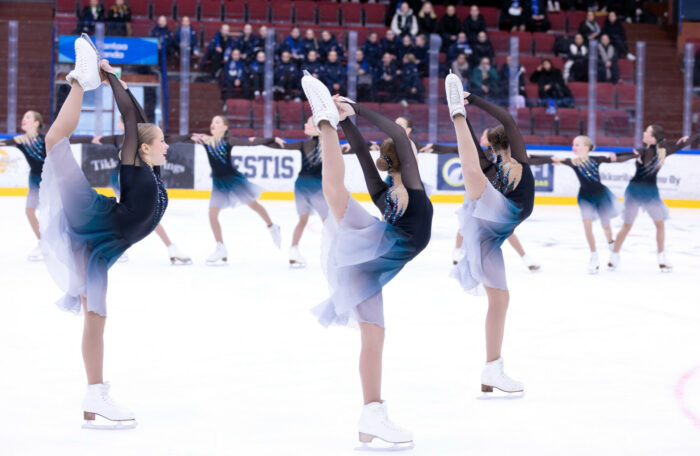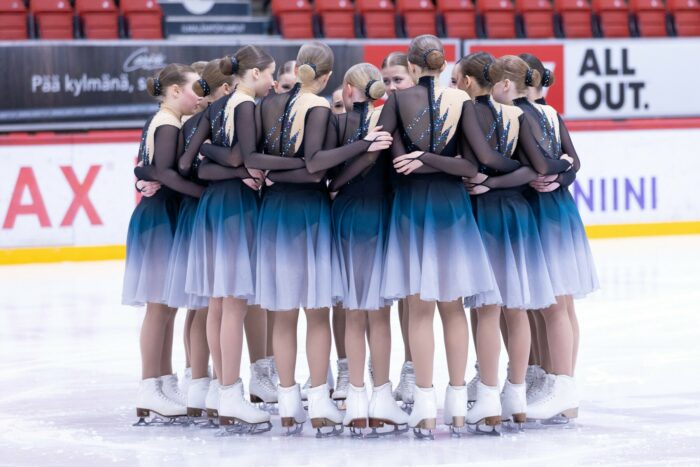Speed, movement, music and choreography contribute to the growing popularity of synchronised skating, a discipline in which Finland holds multiple world championship medals. The international Finlandia Trophy and Marie Lundmark Trophy competitions are held yearly in the Helsinki area.
The 2025 World Synchronised Skating Championship will take place in Finland. In spring 2024, when it was held in Zagreb, Croatia, Finnish teams won bronze and fourth place.
“Figure skating is a multifaceted sport, because it combines athletics and aesthetics,” says synchronised skating coach Katariina Luotonen. “You can express yourself through movement and music and practise skating along with dance, ballet and gymnastics to improve your body power and grace. The feeling when you are speeding across the ice is amazing.”
Popular and still growing

To build their skills, routines and endurance, the Sunlights team trains five times a week on ice, in addition to dance classes and fitness training.Photo: Catarina Stewen
Luotonen began figure skating at five and participated in both single figure skating and synchronised skating with one of Finland’s top teams, Marigold Ice Unity. She later moved into coaching, and works with Helsingin Luistelijat (Helsinki Skaters). It’s the same club she skated with in her youth; she was on the team when they won the world championship in 2002.
Always popular in Finland, figure skating continues to grow, attracting people of all ages. Clubs throughout Finland offer training in single (individual) skating, synchronised (group) skating and ice dance in pairs.
Synchronised skating, especially, has seen a rise in popularity since the 1990s. It’s a team sport in which eight to 20 skaters perform a programme together. It utilises the same judging system as other figure skating events, and is characterised by teamwork, speed, intricate formations and challenging step sequences.
“Being a single skater is very competitive, and most of the time you train by yourself,” Luotonen explains. “Synchronised skating is a team sport, which makes it more fun. As with all team sports, the team spirit comes from doing things together and working towards a common goal. The support from your team members while sharing success, failure, joy and sorrow are assets that will stay with you throughout your life.”
Every child learns to skate
Watch Team Marigold Ice Unity of Finland skate in 2022, the same year they won silver in the World Synchronised Skating Championship in Hamilton, Canada.
Ice skating is regarded as a basic skill in Finland, comparable to swimming or riding a bike. Every child learns to skate at a young age. Because of the long winters, they also have ample opportunity to practice outdoors, as many soccer fields are transformed into ice rinks.
Children of all ages gather after school to play ice hockey or figure skate with their friends. Ice skating is also included in physical education lessons at school.In addition nearly every city has indoor skating rinks, many of which are in year-round use.
Luotonen believes several reasons exist for the growing popularity of synchronised skating: “The team spirit, the show element and the success of Finnish skating teams in competitions all over the world are drawing more and more children to this sport.”
The Finnish senior synchronised skating teams Marigold Ice Unity, Rockettes and Team Unique, all based in Helsinki, have taken turns representing Finland at the World Championship, winning first place a total of nine times. Another challenger is Lumineers from Espoo, just west of Helsinki.
Meanwhile, the success of individual figure skaters such as Emmi Peltonen, Kiira Korpi, Laura Lepistö and Viveca Lindfors has made them into idols for young skating enthusiasts.
No age limit for a new hobby

In team sports such as synchronised skating, participants gain a lot of support from their peers.Photo: Catarina Stewen
“If you wish to be successful [at the top level], you need to start early,” Luotonen says, but adds that there is no age limit to when you can start a new hobby. You can start lessons as early as three years old, but skating lessons and teams for adult beginners are also available.
“Sunlights, one of the teams I am coaching at Helsingin Luistelijat, consists of 29 energetic girls age 9 to 13,” says Luotonen. “They’re such a fun, spontaneous group – they always make me laugh. They train on ice five times a week, in addition to dance classes and fitness training.
“My goal is to teach skaters to grow into young athletes, making healthy choices in all parts of life in order to achieve certain targets. At this age, targets are not measured in results or medals, but in growth on a personal and team level.”
By Catarina Stewen, updated April 2024




